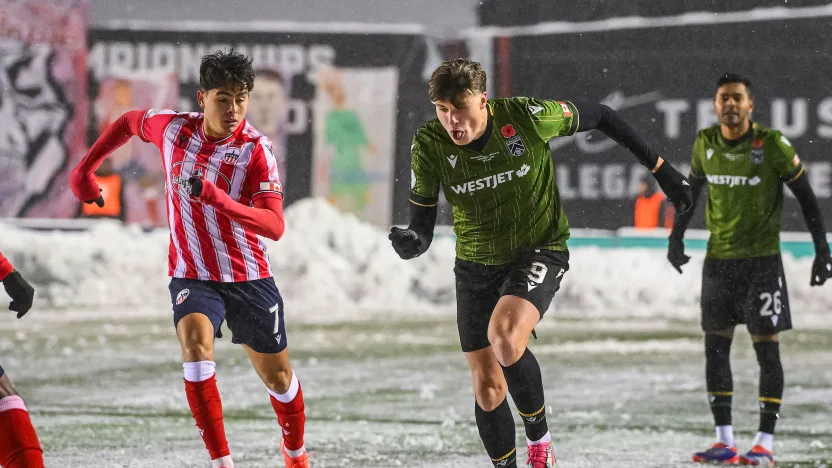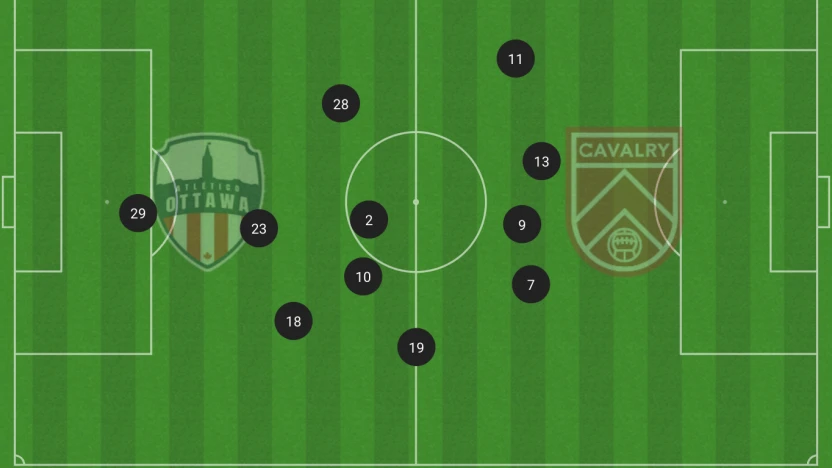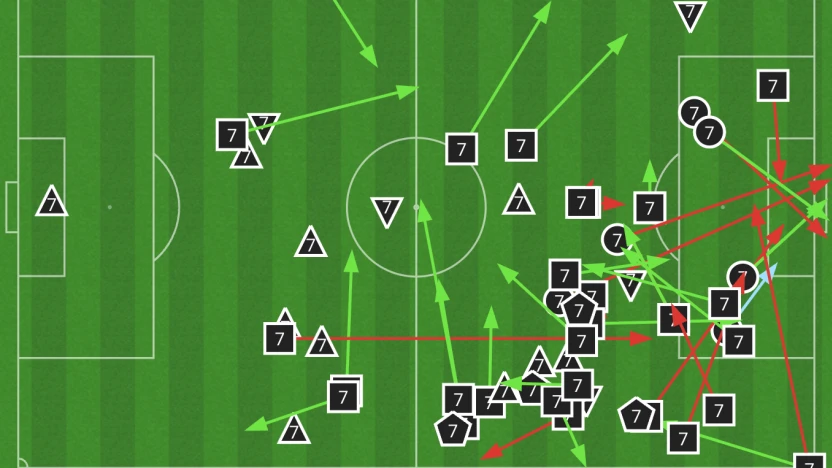How Atlético Ottawa adapted unique game model in 2025 CPL Final win
What happens when your game plan gets challenged by circumstances out of your control?
Usually, you have two choices: stick to your principles and ride them out until the end, or adapt and survive.
In the 2025 CPL Final, Atlético Ottawa and Cavalry faced a unique set of circumstances, and to their credit, they both adapted extremely well, setting the stage for one of the most memorable matches in league history.
Despite dealing with an onslaught of snow, as Ottawa endured weather fitting of this time of the year in Canada, both teams played through it quite well, and combined for a game that featured standout individual performances, highlight-reel goals, players shovelling snow and much more.
As a result, it’s only fair to tip the cap to both Ottawa, who lifted their first-ever North Star Cup in impressive fashion, and Cavalry, who only lost the chance to defend their 2024 North Star Cup crown to a goal in the 107th minute of extra time. Such is the brutal nature of a final - there is only one winner, but it certainly feels unfair to bestow the label of ‘loser’ on any team that goes out swinging the way both teams did in this final.

To stick with Ottawa, though, who avenged their 2-0 loss to Forge at home in the 2022 CPL Final, it’s worth highlighting how they got the job done on the day, however.
Of any team in the CPL this season, they stood to be the one that would suffer the most from a match like this, at least in terms of how it impacted their style of play, which places a lot of emphasis on passing, ball control and dynamic offensive play - things that aren’t exactly easy to do in the snow.
Having averaged an impressive 58 per cent of possession in the regular season, which was 5 per cent more than any other team in the league (fittingly, the second-best side was Cavalry with 53 per cent), while also sitting with an average pass completion rate of 88.7 per cent (the next best team was Forge with 85.7 per cent), Ottawa had certainly proven that they were a formidable unit on the ball all year - one in which they scored a league record 54 goals, by the way.
Because of that, it’s certainly jarring to look at the statistics from the final and see that Ottawa finished with just 53.4 per cent possession and a pass completion rate of 69.6 per cent, as that gives an idea of what they were up against in this game.
Despite that, they didn’t let it affect them, as they still stuck to their principles while slightly altering the game plan where they saw fit - like we see below.
There might be no better example of what that looks like than their second and winning goal, which came from a bit of play that wasn’t typical of this Ottawa side.
On that play, Manny Aparicio did well to pick up the ball in midfield and spied the run of David Rodríguez, who had already left his mark on the game with his earlier ‘Icicle Kick’ that had seemingly been seen around the world within hours of the match's conclusion.
Usually, in normal circumstances, Aparicio, who found Rodríguez with a delicate left-footed ball over the top, might’ve been hesitant to play the pass he did. Perhaps, his instinct would’ve been to play it wide to his left wing back, Gabriel Antinoro, or into the feet of someone in his front three, like striker Sam Salter, sticking to the sort of methodical build-up his team was known for.
Instead, Aparicio took a risk by playing a direct pass, which set the stage for Rodríguez to score a deft chip that stood as the winner.
Yet, that was the balance that Ottawa struck in this game. Surprisingly, they had some moments of extended build-up play despite the conditions, doing well to show their quality in spurts.
Despite the risk that it posed, they continued to push their wing-backs high up the pitch in their 3-4-2-1 formation and tried to create the sort of offensive overloads that have caused problems to teams all year long.

By doing that, they hoped to pin Cavalry back and make them less dangerous on the counter-attack- they were defending by attacking, if you will, something they also did quite well this season.
Then, at the edge of the box, they tried to still combine with short, intricate passing sequences to try and create shooting opportunities, some of which almost paid off, including a great second-half sequence that almost culminated in a second-half goal from Ballou Tabla.
While they had a few moments where they didn’t look like themselves - it was interesting to see them go long a lot more out of the back, which almost didn’t happen in the regular season, and to see them press less intensively - they also didn’t fully abandon who they were, either.
By doing that, it allowed their players to step up the way they did, too, which is key.
For example, Rodríguez was actually another great example of what Ottawa’s adaptability looked like. Despite playing in weather he hadn’t seen much of before signing with Ottawa, having spent most of his career in warmer climates, the ball still stuck to his feet in the snow, much like it has all season long.
As a result, he put up numbers that would’ve been excellent in normal conditions, much less in these - along with his two goals, he had six shots, created two chances, completed 19 of 26 passes (73 per cent), had 10 touches in Cavalry’s box and completed three out of five dribbles.

In a match as big as this one, that ended up going a long way for his team, as he showed the sort of game-breaking quality that helped his team lift a trophy on the day.
If anything, though, that’s the story of this Ottawa team. While they’re a team with a clearly defined style of play and game plan, one that didn’t change from their first game of the season on April 5th to their last one on November 9th, they’ve also got individual players capable of making the difference in key moments.
For example, they also showed that two weeks earlier in the Championship Semifinal against Forge, where they picked up a huge win to advance straight to the CPL Final despite losing the CPL Shield by two points to that same Forge side just a week earlier during ‘The Outcome’.
On that day, Ottawa picked up a massive 2-1 win thanks to goals from Gabriel Antinoro and Sam Salter - in particular, Antinoro’s goal was quite important as he tied the game at 1-1 after Forge struck first early, which is usually a death knell for most teams playing them at Hamilton Stadium.
While Antinoro’s goal was a spectacular, mazy effort that saw him pick the ball up at half before slaloming through a few defenders and curling the ball into the top corner, it wasn’t the sort of goal Ottawa had typically scored - not that they minded. Sometimes, you’ll eschew the sort of intricate and impressive team goals they’ve scored all year long for a bit of individual brilliance.
Ultimately, though, that’s what good teams need to be able to do in big games. Sometimes, you need to be able to grind out a result as a team, and sometimes, you need an individual moment of magic - and often, it helps to have both.
In this final, Ottawa were able to grind as a team while also finding a few moments of magic, and that helped them overcome the challenges that arose on the day, allowing them to lift their first North Star Cup in front of their home fans.
"It doesn't exist, a plan to play in the snow," Ottawa head coach, Diego Mejía, said afterward. "We talked about how we needed to play with pride, with our heads, but then, at the beginning of the game, our guys started to play in the snow, the same way we played all season."

